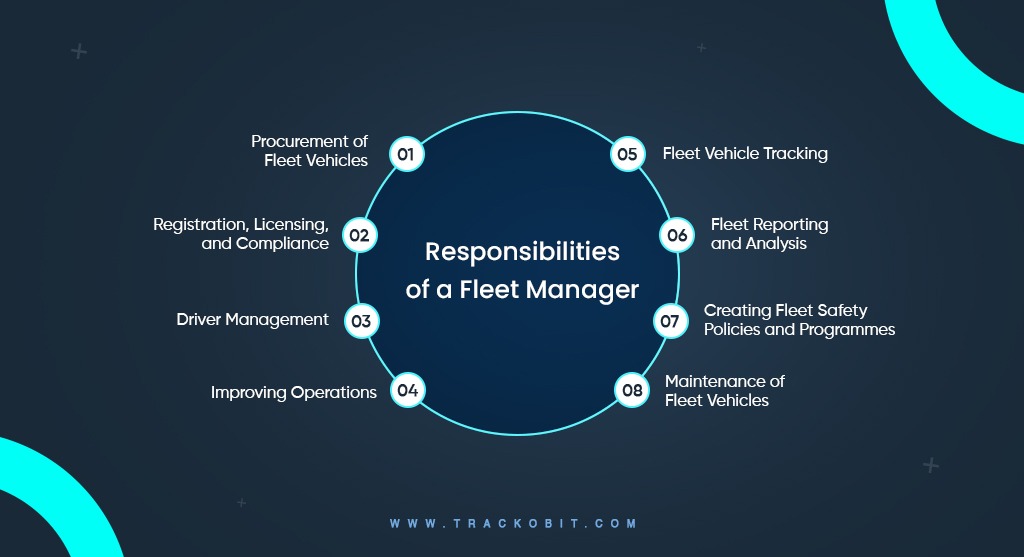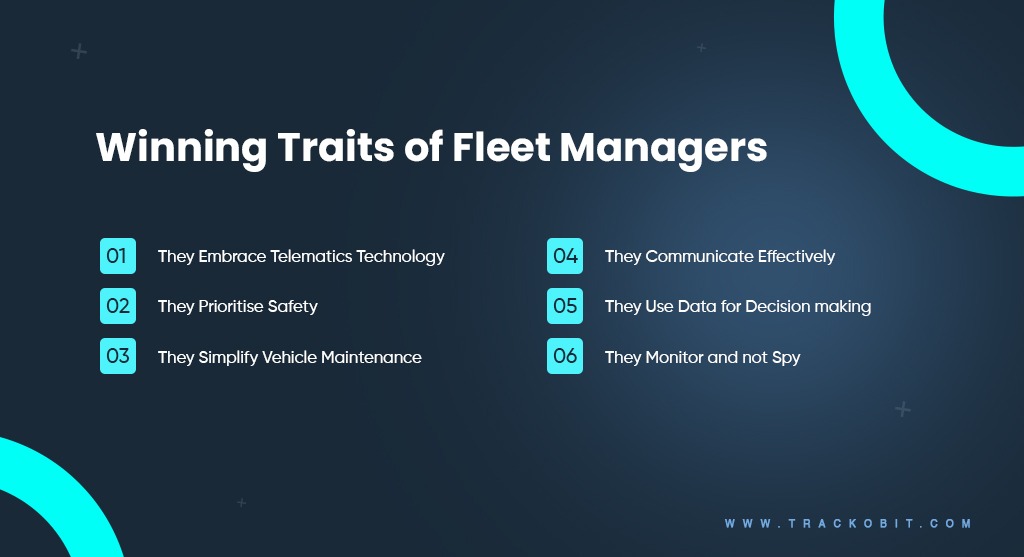-
TrackoBit
Manage commercial vehicles with the new-age Fleet Management Software
TrackoBit -
TrackoField
Streamline your scattered workforce with Field Force Management Software
TrackoField -
Features Resources
-
Blog
Carefully curated articles to update you on industrial trends. -
White Paper
Insightful papers and analysis on essential subject matters. -
Glossary
Explore an alphabetical list of relevant industry terms. -
What’s New
Get TrackoBit & TrackoField monthly updates here. -
Case Study
Explore the cases we solved with our diverse solutions. -
Comparisons
Compare platforms, features, and pricing to find your best fit.
-
About Us
Get to know TrackoBit: our team, ethos, values, and vision. -
Careers
Join the most dynamic cult of coders, creatives and changemakers. -
Tech Support
Learn about our technical support team and services in detail. -
Events
Check out the exhibitions where we left our marks and conquered. -
Contact Us
Connect with us and let us know how we can be of service.
Responsibilities of Fleet Managers and How TrackoBit Can Assist
- Author:Tithi Agarwal
- Read Time:10 min
- Published:
- Last Update: September 17, 2025
Table of Contents
Toggle
What do fleet managers do? What are their duties, responsibilities, and challenges? And what makes a fleet manager effective and successful? This blog answers all these questions.
Table of Contents
Toggle
I plan the routes and track the miles,
Ensure maintenance and manage files.
I keep the fleet running, safe, and sound,
Without me, chaos would be found.
Who am I?
Ans—Of course, a fleet manager.
Picture this: As soon as possible in the morning, you have fifty cars and drivers to dispatch, monitor, and manage. This is because you spend the afternoon formulating fleet regulations and looking for methods to cut expenses and operational difficulties. If this sounds like any other Tuesday, you’re most likely a fleet manager.
Many skilled people aspire to become fleet managers, as the profession offers an average pay of over $89K in the United States. Logistics companies depend on highly skilled individuals for fleet management, and it’s not just about the attractive pay and opportunity.
We examine the role of a fleet manager in detail today. What kinds of abilities do they have? What kinds of duties do they carry out?
And, finally, what kind of tech is there to help fleet managers carry their load?
Let’s start at the beginning.
What is a Fleet Manager?
The person in charge of overseeing an organization’s fleet of vehicles is known as the fleet manager. This covers every facet, from finding or employing drivers to ensuring the effective utilisation of vehicles and reducing delivery times and costs.
Fleet managers assist each vehicle and fleet in navigating and mitigating the tasks and obstacles to which they are assigned. They also monitor the company’s fleet operations to ensure they are safe, efficient, and compliant with traffic laws.
Fleet managers are also in charge of planning, assigning, and overseeing the expenses associated with owning, leasing, or renting vehicles, as well as the operational costs of maintaining and managing them. In addition to drafting driver travel itineraries, they must design regulations addressing vehicle usage and driver behavior based on the business’s needs.

7 Prime Duties and Responsibilities of a Fleet Manager
The fleet manager’s job is not limited to just coordinating with the drivers and monitoring their activities and locations. Here are some of the major roles, responsibilities, and duties that a fleet manager cannot overlook:
1. Procurement and Maintenance of Fleet Vehicles
Fleet managers’ primary responsibility is ensuring the organisation has the appropriate number and kind of vehicles in good shape and condition for optimal trip assignment.
Fleet managers usually purchase or lease vehicles according to certain specifications, such as business type, delivery requirements, load capacity, and mileage.
Fleet managers also perform a comprehensive, timely check-up on vehicles to diagnose their engine health and maintenance needs. Based on that, they set up maintenance and servicing reminders and fill out eDVIR reports through fleet management software—just to prevent mid-route vehicle breakdowns and delays in consignment delivery and keep drivers stress-free and safe.
2. Registration, Licensing, and Compliance
As important as it is, compliance is equally challenging for trucking and transportation companies. In 2023, HOS violations accounted for over 40% of the driver-related violations found during roadside inspections.
Long-haul carriers, in particular, face many regulations. For example, all fleet vehicles must have working ELD devices and ADAS integration, and all drivers must meet HOS requirements.
Fleet managers ensure all fleet vehicles are registered and licensed according to local, state, and federal regulations. They maintain compliance by regularly updating registrations, conducting inspections, adhering to safety standards, and keeping accurate records to avoid fines and ensure smooth operations.
If you wonder how they are so organized and remember all of this, they digitally manage paperwork and set reminders for permits and licenses using vehicle telematics solutions.
3. Driver Management
Another important responsibility of the fleet manager for many businesses is managing the drivers. This covers daily communications, route management, hiring, training, and scheduling.
They ensure that the drivers’ documents are complete, they are assigned duties, and they have an itinerary for the day. Most of all, they ensure that they are logged in to their driver apps to manage attendance, enable tracking, and regulate to-and-fro communication.
Large organizations occasionally assign a fleet dispatcher to this position; however, smaller companies frequently combine the dispatcher and management positions.

4. Improving Operational Efficiency
Lastly, the fleet manager supervises and evaluates activities to enhance workflows and eventually raise the fleet’s total efficiency.
Fleet managers establish procedures for typical difficulties (e.g., inability to complete delivery, accidents, or driver absenteeism ) and use technologies like fleet management software to systematize or automate everyday activities. They also monitor driver records to ensure drivers adhere to routes correctly. They mostly use driver scorecards to track drivers’ performance and reward or coach them.
They do it efficiently using video telematics systems and driver behaviour monitoring solutions that provide visual footage of drivers’ driving behavior in the fleet. They even get intimated about odd driving events like harsh acceleration, brakes, and irregular driving patterns that put pressure on the engine.
5. Live Fleet Vehicle Tracking
Fleet vehicle tracking is crucial because it provides fleet managers with a comprehensive picture of their fleet’s performance while driving. Fleet managers track the whereabouts, status, and physical state of their cars in real time, as well as the actions of their drivers, using GPS and vehicle tracking software.
6. Fleet Reporting and Analysis
Fleet managers must then create reports using the metrics obtained from vehicle tracking. These reports list a fleet’s key performance indicators (KPIs) and let managers call out any areas in which it is deficient. Information about fuel usage, asset utilisation, and idle time is definitely included. A fleet manager will leverage this data to plan better routes and halts.
7. Creating Fleet Safety and Policies and Programmes
Given that on-road accidents can be lethal and damaging to an organization’s reputation, fleet managers have a fiduciary duty to protect the safety of their drivers. Thus, it’s imperative that fleet management develop explicit safety standards, carry out driver training initiatives that promote safe driving practices, and have the capacity to act quickly if an incident does arise.
Fleet Manager Responsibilities Specifically Toward the Company’s Drivers
The following is a list of driver management operations a fleet manager may oversee:
- Monitoring, correcting, and improving driving behaviors and operations
- Mentoring, coaching, and rewarding drivers
- Assisting in the recruitment, discipline, and termination of drivers
- Evaluating drivers’ performances
- Setting driving schedules
- Tracking driver attendance, health, and other statuses
- Ensuring drivers’ adherence to applicable transport regulations (e.g., Hours of Service compliance)
- Providing route and operations information and technologies
- Maintaining constant communication with drivers
- Training drivers on risk management protocols, safety standards, and more
What Makes a Highly Efficient Fleet Manager?
Below are some of the traits of an effective fleet manager:
1. They Embrace Technology
Successful fleet managers welcome and adopt new technology that can enhance business processes.
An ideal fleet manager leverages telematics software and technology to optimize fleet performance and efficiency. By utilizing GPS tracking, they monitor vehicle locations in real-time, improving route planning and reducing fuel consumption. Telematics provides critical data on vehicle diagnostics, enabling proactive maintenance and minimizing downtime.
With advanced analytics, fleet managers can assess driver behavior, identify harsh braking or speeding patterns, and implement targeted training programs to enhance safety and reduce vehicle wear and tear.
An ideal fleet manager uses telematics to boost productivity, ensure compliance, enhance safety, and reduce operational costs.
2. They Prioritise Safety
Highly effective fleet managers understand that safety is the priority.
When safety is compromised, not only general motorists but also heavy commercial trucks are exposed to life-threatening risks. On the other hand, the company is just one accident away from paying hundreds of thousands, if not millions, worth of legal penalties.
Fleet managers prioritize driver and vehicle safety by implementing comprehensive training programs to promote safe driving practices. They use telematics to monitor driver behavior, addressing issues like speeding or harsh braking. Regular vehicle inspections and maintenance schedules ensure vehicles are in optimal condition.
Fleet managers enforce adherence to regulatory standards and conduct safety audits. They also equip vehicles with safety technology, such as collision avoidance systems and dashcams. By fostering a culture of safety and providing continuous education, fleet managers aim to reduce accidents, enhance driver well-being, and maintain a reliable fleet.
3. They Simplify Vehicle Maintenance
Regular vehicle maintenance is required, but it can be laborious and time-consuming.
Cloud-based fleet management software helps fleet managers optimise every step of the vehicle maintenance procedure. This streamlines the procedure and improves fuel efficiency.
Fleet managers simplify vehicle maintenance by implementing routine maintenance schedules to prevent breakdowns. They use telematics to monitor vehicle health and receive real-time alerts for issues, enabling proactive servicing. Fleet management software tracks maintenance history, schedules services, and automates reminders for upcoming tasks. Ultimately, this will reduce downtime and maintenance costs while ensuring the fleet remains in optimal condition.
4. They Communicate Effectively
Fleet managers put a premium on effective communication.
Effective communication means:
- Drivers fully understand what fleet managers’ expectations are.
- Fleet managers keep their clients and industry partners updated.
- Fleet managers establish a friendly work environment and encourage the staff to express their observations.

5. They Never Coerce Drivers
Good fleet managers note their drivers’ workloads and do not compel their drivers to work longer than their allotted hours of service.
They are aware that forcing drivers to do anything is against the HOS regulations and leads to disgruntled employees, jeopardized fleet security, and decreased driver retention rates.
Ensuring drivers are happy with their jobs and feel valued is within the purview of fleet managers’ duties.
6. They Use ELD Data and Insights
ELDs do so much more than just help companies comply with the regulations. They provide vital data and insights that fleet managers can leverage.
For example, fleet managers can regularly monitor their drivers’ performances and identify bad driving habits, such as harsh braking, sharp cornering, hard acceleration, and idling. These dangerous driving behaviors are safety risks that fleet managers should work to eliminate.
7. They Work Wisely
Highly effective fleet managers understand the importance of working smarter, not harder.
They value their time and effort, so they use innovative, high-quality technology to complete their tasks faster instead of slower manual and traditional methods. As a result, they save time and company resources while producing higher-quality work.
Let’s take the fuel consumption calculation as an example. Manual calculation is tedious, requiring dozens of hours to complete, and prone to errors.
Instead, fleet managers can use automated fuel monitoring software to generate reports, monitor fleet performances, track location, and maintain vehicle health.
How TrackoBit is Making Fleet Managers’ Job a Lot Easier
It’s kind of like the Swiss Army knife in a fleet manager’s toolbox. But instead of scissors and a magnifying glass, you get features that make the life of any fleet manager much easier.
Below, we cover a few vital ways it helps fleet managers save time, improve efficiency and hit their KPIs.
Assist in Planning Efficient Routes, Halts and Trips
Real-time GPS tracking provides accurate location data, enabling managers to monitor vehicle movements and make real-time adjustments to improve route efficiency. Geofencing capabilities allow managers to set virtual boundaries and receive instant alerts.
Analyse Every Driver’s and Vehicle’s Performance with TrackoBit’s State of the Art Features
TrackoBit’s driver behavior monitoring and route monitoring feature shows both the planned and actual driven routes. A colored line shows the driver’s planned route, and a dotted line shows the actual driven route accompanied by deviation alerts.
Digitalise Vehicle Maintenance with DVIR and Reminders
TrackoBit digitalizes vehicle maintenance using DVIR and automated reminders. DVIR enables drivers to perform and log inspections via a mobile app, ensuring timely detection of issues. The data is instantly accessible to fleet managers, facilitating quick decision-making and maintenance scheduling.
Conclusion
Being a fleet manager is no easy job. However, it becomes easier and more efficient with proper training and the right tools. Fleet management software like TrackoBit was built after understanding every operational challenge and psyche of different fleet managers. This means the biggest challenges are addressed by technology so that you can focus on what software can’t do – be a manager people want to work with.
If you have more questions about how TrackoBit can help your logistics team, book a free demo and see the software in action.
Tithi Agarwal is an established content marketing specialist with years of experience in Telematics and the SaaS domain. With a strong background in literature and industrial expertise in technical wr... Read More
Related Blogs
-

When Tracking Needs a Clock: Rethinking Fleet Visibility
Tithi Agarwal December 24, 2025Read on to understand why fleet tracking works better when it follows working hours. Because visibility should support operations, not…
-

What Makes TrackoBit’s Video Telematics Software Truly Next-Gen?
Shemanti Ghosh December 17, 2025TrackoBit’s video telematics software blends smart video intelligence with full server control. The result? Superior fleet reliability and safety.
-

Plug, Pair, Perform TrackoBit Introduces BLE Sensor Integration
Tithi Agarwal November 26, 2025TrackoBit’s BLE Sensor Integration enables wireless, real-time monitoring with faster installs and accurate insights. It improves fleet efficiency, visibility, and…
-

How to Use Driver Behavior Reports as a Sales Hook to Close Big Fleets
Tithi Agarwal October 16, 2025TrackoBit’s driver behavior reports empower fleet providers to win big contracts by showcasing safety, efficiency, and measurable ROI.

Subscribe for weekly tips to optimize your fleet’s potential!
Your inbox awaits a welcome email. Stay tuned for the latest blog updates & expert insights.
"While you're here, dive into some more reads or grab quick bites from our social platforms!"Stay Updated on tech, telematics and mobility. Don't miss out on the latest in the industry.
We use cookies to enhance and personalize your browsing experience. By continuing to use our website, you agree to our Privacy Policy.


































